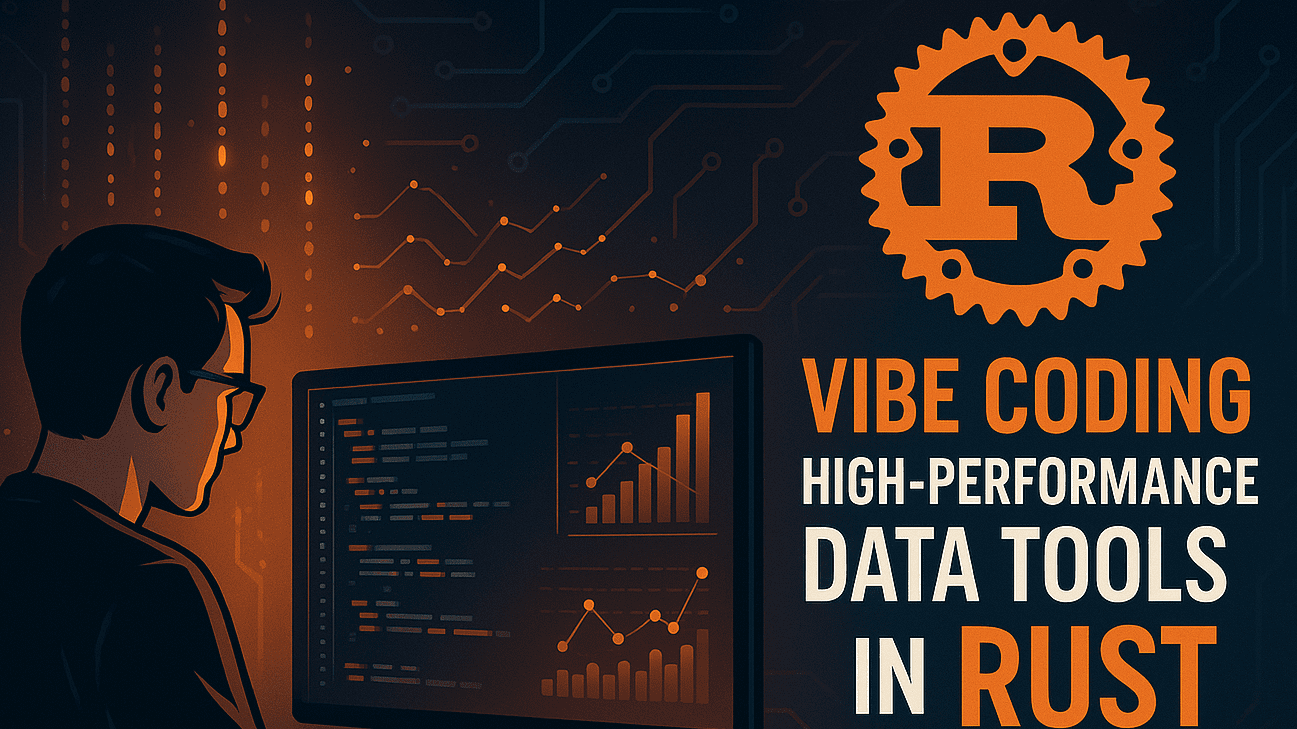AI in Travel
Vibe Coding High-Performance Data Tools in Rust


Image by Author | ChatGPT
Working with data is everywhere now, from small apps to huge systems. But handling data quickly and safely isn’t always easy. That’s where Rust comes in. Rust is a programming language built for speed and safety. It’s great for building tools that need to process large amounts of data without slowing down or crashing. In this article, we’ll explore how Rust can help you create high-performance data tools.
# What Is “Vibe Coding”?
Vibe coding refers to the practice of using large language models (LLMs) to produce code based on natural language descriptions. Instead of typing out every line of code yourself, you tell the AI what your program should do, and it writes the code for you. Vibe coding makes it easier and faster to build software, especially for people who don’t have a lot of experience with coding.
The vibe coding process involves the following steps:
- Natural Language Input: The developer provides a description of the desired functionality in plain language.
- AI Interpretation: The AI analyzes the input and determines the necessary code structure and logic.
- Code Generation: The AI generates the code based on its interpretation.
- Execution: The developer runs the generated code to see if it works as intended.
- Refinement: If something isn’t right, the developer tells the AI what to fix.
- Iteration: The iterative process continues until the desired software is achieved.
# Why Rust for Data Tools?
Rust is becoming a popular choice for building data tools due to several key advantages:
- High Performance: Rust delivers performance comparable to C and C++ and handles large datasets quickly
- Memory Safety: Rust helps manage memory safely without a garbage collector, which reduces bugs and improves performance
- Concurrency: Rust’s ownership rules prevent data races, letting you write safe parallel code for multi-core processors
- Rich Ecosystem: Rust has a growing ecosystem of libraries, known as crates, that make it easy to build powerful, cross-platform tools
# Setting Up Your Rust Environment
Getting started is straightforward:
- Install Rust: Use rustup to install Rust and keep it updated
- IDE Support: Popular editors like VS Code and IntelliJ Rust make it easy to write Rust code
- Useful Crates: For data processing, consider crates such as
csv,serde,rayon, andtokio
With this foundation, you’re ready to build data tools in Rust.
# Example 1: CSV Parser
One common task when working with data is reading CSV files. CSV files store data in a table format, like a spreadsheet. Let’s build a simple tool in Rust to do just that.
// Step 1: Adding Dependencies
In Rust, we use crates to help us. For this example, add these to your project’s Cargo.toml file:
[dependencies]
csv = "1.1"
serde = { version = "1.0", features = ["derive"] }
rayon = "1.7"
csvhelps us read CSV filesserdelets us convert CSV rows into Rust data typesrayonlets us process data in parallel
// Step 2: Defining a Record Struct
We need to tell Rust what kind of data each row holds. For example, if each row has an id, name, and value, we write:
use serde::Deserialize;
#[derive(Debug, Deserialize)]
struct Record {
id: u32,
name: String,
value: f64,
}
This makes it easy for Rust to turn CSV rows into Record structs.
// Step 3: Using Rayon for Parallelism
Now, let’s write a function that reads the CSV file and filters records where the value is greater than 100.
use csv::ReaderBuilder;
use rayon::prelude::*;
use std::error::Error;
// Record struct from the previous step needs to be in scope
use serde::Deserialize;
#[derive(Debug, Deserialize, Clone)]
struct Record {
id: u32,
name: String,
value: f64,
}
fn process_csv(path: &str) -> Result<(), Box> {
let mut rdr = ReaderBuilder::new()
.has_headers(true)
.from_path(path)?;
// Collect records into a vector
let records: Vec = rdr.deserialize()
.filter_map(Result::ok)
.collect();
// Process records in parallel: filter where value > 100.0
let filtered: Vec<_> = records.par_iter()
.filter(|r| r.value > 100.0)
.cloned()
.collect();
// Print filtered records
for rec in filtered {
println!("{:?}", rec);
}
Ok(())
}
fn main() {
if let Err(err) = process_csv("data.csv") {
eprintln!("Error processing CSV: {}", err);
}
}
# Example 2: Asynchronous Streaming Data Processor
In many data scenarios — such as logs, sensor data, or financial ticks — you need to process data streams asynchronously without blocking the program. Rust’s async ecosystem makes it easy to build streaming data tools.
// Step 1: Adding Asynchronous Dependencies
Add these crates to your Cargo.toml to help with async tasks and JSON data:
[dependencies]
tokio = { version = "1", features = ["full"] }
async-stream = "0.3"
serde_json = "1.0"
tokio-stream = "0.1"
futures-core = "0.3"
tokiois the async runtime that runs our tasksasync-streamhelps us create streams of data asynchronouslyserde_jsonparses JSON data into Rust structs
// Step 2: Creating an Asynchronous Data Stream
Here’s an example that simulates receiving JSON events one by one with a delay. We define an Event struct, then create a stream that produces these events asynchronously:
use async_stream::stream;
use futures_core::stream::Stream;
use serde::Deserialize;
use tokio::time::{sleep, Duration};
use tokio_stream::StreamExt;
#[derive(Debug, Deserialize)]
struct Event {
event_type: String,
payload: String,
}
fn event_stream() -> impl Stream- {
stream! {
for i in 1..=5 {
let event = Event {
event_type: "update".into(),
payload: format!("data {}", i),
};
yield event;
sleep(Duration::from_millis(500)).await;
}
}
}
#[tokio::main]
async fn main() {
let mut stream = event_stream();
while let Some(event) = stream.next().await {
println!("Received event: {:?}", event);
// Here you can filter, transform, or store the event
}
}
# Tips to Maximize Performance
- Profile your code with tools like
cargo benchorperfto spot bottlenecks - Prefer zero-cost abstractions like iterators and traits to write clean and fast code
- Use async I/O with
tokiowhen dealing with network or disk streaming - Keep Rust’s ownership model front and center to avoid unnecessary allocations or clones
- Build in release mode (
cargo build --release) to enable compiler optimizations - Use specialized crates like
ndarrayor Single Instruction, Multiple Data (SIMD) libraries for heavy numerical workloads
# Wrapping Up
Vibe coding lets you build software by describing what you want, and the AI turns your ideas into working code. This process saves time and lowers the barrier to entry. Rust is perfect for data tools, giving you speed, safety, and control without a garbage collector. Plus, Rust’s compiler helps you avoid common bugs.
We showed how to build a CSV processor that reads, filters, and processes data in parallel. We also built an asynchronous stream processor to handle live data using tokio. Use AI to explore ideas and Rust to bring them to life. Together, they help you build high-performance tools.
Jayita Gulati is a machine learning enthusiast and technical writer driven by her passion for building machine learning models. She holds a Master’s degree in Computer Science from the University of Liverpool.
AI in Travel
Travel Recovery and AI Strategy Divergences

It involves the strategic direction and implementation of AI and content integration, which are crucial for user experience and platform competitiveness.
How will the AI and content strategy operate over the next few years? Can you describe the recent Trip.Planner upgrade? – Alex C. Yao (JPMorgan Chase & Co, Research Division)
2025Q2: The integration of AI and content creates powerful synergies across our platform. AI enhances content by delivering personalized intelligent recommendations, while a rich content ecosystem strengthens our AI models. – Jianzhang Liang(CEO)
How do AI initiatives like Trip.Best and TripTrends affect business outcomes? – Jiong Shao (Barclays Bank PLC, Research Division)
2024Q2: We have integrated AI tools on our platforms like Trip.Best, TripTrends, and TripGenie to enhance user experience and operational efficiency, demonstrating the versatility and potential of AI in various scenarios. – James Liang(CEO)
AI in Travel
Travel trust gap widens as AI fraud fears grow – Gadget

Nearly half of global consumers (44%) lack confidence in the travel industry’s ability to protect them from AI-powered fraud including identity theft and account takeover fraud.
This is revealed in the 2025 Online Identity Study by Jumio, a provider of AI-powered identity intelligence anchored in biometric authentication, automation and data-driven insights. The study surveyed 8,001 adults in the United States, United Kingdom, Singapore, and Mexico between 9 and 24 April 2025.
For the sharing economy (including vacation rentals and other travel-focused gig economy services), confidence falls even further, with 55% in the UK and 50% globally saying they don’t feel adequately protected.
Consumers share sensitive personal data for a simple vacation, often providing government-issued IDs such as passports or drivers’ licences to book flights, check into hotels, and rent cars. This exchange of data makes consumers vulnerable to fraud during the summer travel season, and they recognise the risk.
These sentiments trend alongside broader global distrust in digital spaces, with 69% of respondents saying AI-powered fraud now poses a greater threat to personal security than traditional forms of identity theft.
In response to this distrust, consumers worldwide are slightly more willing to invest more time in identity verification on these platforms than in 2024:
- In 2025, 74% of global consumers said they would willingly spend more time on identity verification when accessing travel and hospitality-related platforms if it improved their security, up from 71% in 2024.
- Global willingness to spend time verifying identity on sharing economy platforms also stayed high at 70% in 2025, only slightly down from 71% in 2024, but with a subtle shift from “a lot more time” to “a little more time”. This suggests increased caution, with a remaining preference for low-friction, visible safeguards.
Consumers’ increasing willingness to spend time on identity verification for travel-related transactions follows a growing trend in traditionally higher-risk industries. For instance, 80% of consumers globally were willing to spend more time on security for digital platforms supporting banking and financial services.
“Whether it’s an evacuation plan or a safe in every hotel room, the travel and hospitality industry know how to build the structures and processes customers need to feel safe,” says Bala Kumar, chief product and technology officer at Jumio.
“Now customers expect the same level of care for their personal data. But travel and hospitality businesses can’t keep layering traditional protections on already complex processes – they need new solutions and technologies to balance convenience with protection, even as AI-powered scams evolve.”
* Read the 2025 Jumio Online Identity Study here.
AI in Travel
A Strategic Catalyst for Long-Term Growth

The travel industry is undergoing a seismic shift, driven by two powerful forces: the rise of artificial intelligence (AI) and the explosive growth of China’s inbound tourism sector. At the forefront of this transformation is Trip.com Group (TCOM), a company that has not only embraced AI as a core strategic pillar but has also positioned itself to capitalize on the surging demand for international travel to China. For investors, this is a rare confluence of technological innovation and macroeconomic tailwinds that could redefine the online travel agency (OTA) landscape for years to come.
AI as the Engine of Personalization and Efficiency
Trip.com’s AI-driven ecosystem is no longer a buzzword—it’s a proven revenue driver. The company’s TripGenie platform, a virtual travel assistant powered by advanced language models, has revolutionized the user experience. By enabling seamless transitions from conversational planning to real-time booking, TripGenie has driven a 50% increase in average user session duration in Q1 2025. This isn’t just about convenience; it’s about creating a sticky, data-rich environment where every interaction deepens Trip.com’s understanding of user preferences.
The results? Trip Moments, the company’s user-generated content platform, now sees 100% year-on-year growth in engagement, with 80% of content generated by users. By combining browsing history, past bookings, and AI-driven insights, Trip.com delivers hyper-personalized recommendations that boost conversion rates and customer satisfaction. Meanwhile, AI chatbots and self-service tools handle 80% of customer inquiries, slashing response times and improving service efficiency. This operational edge is critical in an industry where customer experience is the ultimate differentiator.
Inbound Tourism: A New Goldmine for Trip.com
China’s inbound tourism sector is experiencing a renaissance, fueled by aggressive policy reforms. In Q1 2025 alone, the country welcomed 9 million international visitors, a 40% year-on-year surge, with 6.57 million of those trips made under visa-free policies. The 240-hour visa-free transit policy and expanded visa waivers for 47 countries have turned cities like Shanghai into global gateways. Shanghai’s foreign visitor numbers soared 61.9%, with South Korea and Thailand leading the charge.
Trip.com has been laser-focused on capturing this momentum. Its free city tours for transit travelers in Shanghai and Beijing, combined with multilingual service centers, have created a seamless on-the-ground experience for international visitors. The company’s Trip Best product line, which blends AI-driven insights with local expertise, ensures that recommendations for hotels, restaurants, and activities are both data-backed and culturally authentic.
But the real game-changer is the instant VAT refund policy, launched in April 2025. By allowing tourists to receive tax rebates at the point of purchase—instead of waiting until departure—China has made its retail sector far more attractive. Trip.com is leveraging this by promoting high-margin services like cross-border e-commerce and experiential travel packages (e.g., music festivals, sports events) tailored to younger, experience-driven travelers.
Financial Resilience and Strategic Expansion
Trip.com’s Q1 2025 financials tell a compelling story. Net revenue hit RMB 13.8 billion, up 16% year-on-year, with accommodation revenue rising 23% and transportation revenue up 8%. Adjusted EBITDA climbed to RMB 4.2 billion, a 7% increase, underscoring the company’s ability to scale profitably. These figures aren’t just numbers—they’re a testament to Trip.com’s ability to monetize AI-driven efficiency and policy-driven demand.
Looking ahead, the company is doubling down on inbound and senior travel markets, where competition remains fragmented. It’s also eyeing the Middle East, a region poised for tourism growth, and is tailoring offerings to align with visa-free policies and VAT incentives. With James Liang, the Executive Chairman, framing AI as a “cornerstone of long-term strategy,” Trip.com is investing in R&D to stay ahead of the curve.
Why This Is a Buy-and-Hold Opportunity
For investors, the case for Trip.com is clear. The company has mastered the art of scaling AI-driven personalization while riding the inbound tourism wave—a combination that’s hard to replicate. Its financials show resilience, and its strategic moves (e.g., expanding into experiential travel, enhancing offline services) position it to dominate a market that’s still in its early stages of growth.
The risks? Global geopolitical tensions or a slowdown in China’s economic recovery could dampen travel demand. But given the structural tailwinds—from visa reforms to digital infrastructure upgrades—these seem manageable.
Final Call to Action
Trip.com isn’t just adapting to the future of travel; it’s building it. With a 30%+ EBITDA margin, a 20%+ revenue growth trajectory, and a first-mover advantage in AI-powered personalization, TCOM is a stock that deserves a prominent place in any investor’s portfolio. The inbound tourism boom is just getting started, and Trip.com is the captain of this ship.
In a world where travel is becoming smarter, faster, and more personalized, Trip.com is the ultimate winner. Don’t miss the ride.
-

 Brand Stories1 month ago
Brand Stories1 month agoBloom Hotels: A Modern Vision of Hospitality Redefining Travel
-

 Brand Stories1 month ago
Brand Stories1 month agoCheQin.ai sets a new standard for hotel booking with its AI capabilities: empowering travellers to bargain, choose the best, and book with clarity.
-

 Destinations & Things To Do1 month ago
Destinations & Things To Do1 month agoThis Hidden Beach in India Glows at Night-But Only in One Secret Season
-

 Destinations & Things To Do1 month ago
Destinations & Things To Do1 month agoUntouched Destinations: Stunning Hidden Gems You Must Visit
-

 AI in Travel1 month ago
AI in Travel1 month agoAI Travel Revolution: Must-Have Guide to the Best Experience
-

 Family Travel2 months ago
Family Travel2 months agoThings to Do Indoors in New Jersey
-

 Brand Stories2 months ago
Brand Stories2 months agoVoice AI Startup ElevenLabs Plans to Add Hubs Around the World
-

 Brand Stories1 month ago
Brand Stories1 month agoContactless Hospitality: Why Remote Management Technology Is Key to Seamless Guest Experiences
-

 Restaurants & Food5 months ago
Restaurants & Food5 months ago10 New Restaurants In Delhi NCR To Head To This Month
-

 Brand Stories2 months ago
Brand Stories2 months agoHow Elon Musk’s rogue Grok chatbot became a cautionary AI tale

You must be logged in to post a comment Login